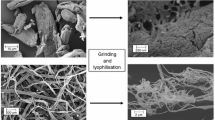Abstract
Thermal decomposition of cellulose has been widely studied for the past several years. It has been reported that the source of cellulose and its composition greatly affect its pyrolysis. One of the most widely used analytical tools for the study of cellulose pyrolysis is thermogravimetric (TG) analysis. Several model-fitting methods have been employed to study cellulose pyrolysis kinetics. An alternative to the model-fitting approach is the so-called model-free method developed by Vyazovkin. This isoconversional technique calculates the activation energy as a function of the degree of the conversion. In this article, the pyrolysis of cellulose in cotton fibers compared to microcrystalline cellulose (Avicel, PH 105) was investigated. TG curves were acquired as a function of the heating rates (4, 5, 8, 10, and 16 °C min−1) and the model-free method was used to analyze the data. Activation energies of cotton fibers and Avicel were obtained, and compared to the data reported in the literature. In addition, models for isothermal decomposition were calculated and compared with experimental data at the same temperature.







Similar content being viewed by others
References
Antal MJJ, Varhegyi G. Cellulose pyrolysis kinetics: the current state of knowledge. Ind Eng Chem Res. 1995;34:703–17.
Abidi N, Hequet E, Cabrales L, Gannaway J, Wilkins T, Wells LW. Evaluating cell wall structure and composition of developing cotton fibers using Fourier transform infrared spectroscopy and thermogravimetric analysis. J App Polym Sci. 2008;107:476–86.
Abidi N, Hequet E, Ethridge D. Thermogravimetric analysis of cotton fibers: relationships with maturity and fineness. J App Polym Sci. 2007;103:3476–82.
Vyazovkin S. Model-free kinetics—staying free of multiplying entities without necessity. J Therm Anal Calorim. 2006;83:45–51.
Vyazovkin S, Sbirrazzuoli N. Isoconversional kinetic analysis of thermally stimulated processes in polymers. Macromol Rapid Commun. 2006;27:1515–32.
Chowlu ACK, Reddy PK, Ghoshal AK. Pyrolytic decomposition and model-free kinetics analysis of mixture of polypropylene (PP) and low-density polyethylene (LDPE). Thermochim Acta. 2009;485:20–5.
Vyazovkin S, Wight CA. Model-free and model-fitting approaches to kinetic analysis of isothermal and nonisothermal data. Thermochim Acta. 1999;341:53–68.
Ramajo-Escalera B, Espina A, Garcia JR, Sosa-Arnao JH, Nebra SA. Model-free kinetics applied to sugarcane bagasse combustion. Thermochim Acta. 2006;448:111–6.
Vyazovkin S, Vincent L, Sbirrazzuoli N. Thermal denaturation of collagen analyzed by isoconversional method. Macromol Biosci. 2007;7:1181–6.
Khawam A, Flanagan DR. Role of isoconversional methods in varying activation energies of solid-state kinetics—I. Isothermal kinetic studies. Thermochim Acta. 2005;429:93–102.
Saha B, Maiti AK, Ghoshal AK. Model-free method for isothermal and non-isothermal decomposition kinetics analysis of PET sample. Thermochim Acta. 2006;444:46–52.
Vyazovkin S. Advanced isoconversional method. J Therm Anal. 1997;49:1493–9.
Abidi N, Hequet E, Cabrales L. Changes in sugar composition and cellulose content during the secondary cell wall biogenesis in cotton fibers. Cellulose. 2009; doi:10.1007/s10570-009-9364-3.
Opfermann JR, Kaisersberger E, Flammersheim HJ. Model-free analysis of thermoanalytical data-advantages and limitations. Thermochim Acta. 2002;391:119–27.
Gronli M, Antal MJ, Varhegyi G. A round-robin study of cellulose pyrolysis kinetics by thermogravimetry. Ind Eng Chem Res. 1999;38:2238–44.
Calahorra ME, Cortázar M, Eguiazábal JI, Guzmán GM. Thermogravimetric analysis of cellulose: effect of the molecular weight on thermal decomposition. J App Polym Sci. 1989;37:3305–14.
Timpa JD. Application of universal calibration in gel-permeation chromatography for molecular-weight determinations of plant-cell wall polymers—cotton fiber. J Agric Food Chem. 1991;39:270–5.
Timpa JD, Triplett BA. Analysis of cell-wall polymers during cotton fiber development. Planta. 1993;189:101–8.
Varhegyi G, Antal MJ, Szekely T, Till F, Jakab E. Simultaneous thermogravimetric mass-spectrometric studies of the thermal-decomposition of bio-polymers. 1. Avicel cellulose in the presence and absence of catalysts. Energy Fuels. 1988;2:267–72.
Lin YC, Cho J, Tompsett GA, Westmoreland PR, Huber GW. Kinetics and mechanism of cellulose pyrolysis. J Phys Chem C. 2009;113:20097–107.
Antal MJ, Varhegyi G, Jakab E. Cellulose pyrolysis kinetics: revisited. Ind Eng Chem Res. 1998;37:1267–75.
Capart R, Khezami L, Burnham AK. Assessment of various kinetic models for the pyrolysis of a microgranular cellulose. Thermochim Acta. 2004;417:79–89.
Eom Y, Kim S, Kim SS, Chung SH. Application of peak property method for estimating apparent kinetic parameters of cellulose pyrolysis reaction. J Ind Eng Chem. 2006;12:846–52.
Yang PY, Kokot S. Thermal analysis of different cellulosic fabrics. J Appl Polym Sci. 1996;60:1137–46.
Mack CH, Donaldson DJ. Effects of bases on the pyrolysis of cotton cellulose. Text Res J. 1967;37:1063–71.
Chatterjee PK, Conrad C. Kinetics of the pyrolysis of cotton cellulose. Text Res J. 1966;36:487–94.
Yao F, Wu QL, Lei Y, Guo WH, Xu YJ. Thermal decomposition kinetics of natural fibers: activation energy with dynamic thermogravimetric analysis. Polym Degrad Stabil. 2008;93:90–8.
Corradini E, Teixeira EM, Paladin PD, Agnelli JA, Silva O, Mattoso LHC. Thermal stability and degradation kinetic study of white and colored cotton fibers by thermogravimetric analysis. J Therm Anal Calorim. 2009;97:415–9.
Vyazovkin S. What can model free kinetics tell us about reaction mechanisms? Mettler Toledo User Commun. 1999;10:9–10.
Mamleev V, Bourbigot S, Yvon J. Kinetic analysis of the thermal decomposition of cellulose: the main step of mass loss. J Anal Appl Pyrolysis. 2007;80:151–65.
Acknowledgements
The authors would like to thank the Texas Department of Agriculture, Food and Fibers Research Grant Program for providing financial support for this project.
Author information
Authors and Affiliations
Corresponding author
Rights and permissions
About this article
Cite this article
Cabrales, L., Abidi, N. On the thermal degradation of cellulose in cotton fibers. J Therm Anal Calorim 102, 485–491 (2010). https://doi.org/10.1007/s10973-010-0911-9
Published:
Issue Date:
DOI: https://doi.org/10.1007/s10973-010-0911-9




